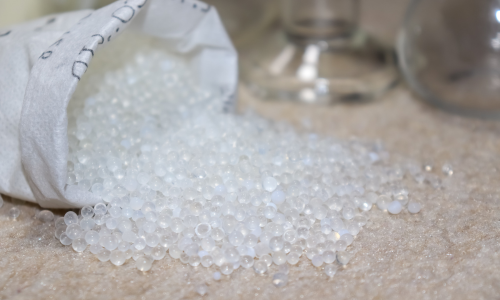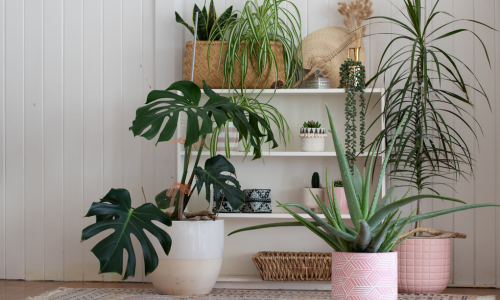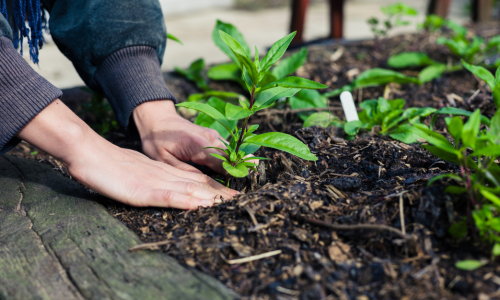Silica, a mineral, is often considered as non-essential (or quasi-essential) for plant growth. Also known as silicon dioxide, silica is a naturally occurring compound made up of silicon and oxygen atoms. It is one of the most common minerals on earth and is found in rocks, sand and soil. Silica is essential for the growth and development of many organisms, including plants and animals.
Silica is a wonder for plants. Here are six of its incredible benefits.
Silica reduces pest populations

Silica reduces pest populations in a natural and non-toxic way. When plants absorb silica, it is deposited into their tissues in the form of phytoliths, which act like tiny shards of glass. These phytoliths create an abrasive surface that makes it more difficult for pests to feed and breed on the plant. This includes pests like aphids, mites and thrips, which can cause significant damage to crops and ornamental plants.
Additionally, the presence of silica in plant tissues can stimulate the production of defensive compounds, such as lignin and phenols, which help to deter pests and reduce the likelihood of infection by fungal and bacterial pathogens. These compounds make the plant less attractive to pests and provide a chemical barrier against pathogens.
Silica can also have an indirect effect on pest populations by promoting plant growth and health. Strong, healthy plants are more resistant to pests and diseases, as they have the resources and energy to defend themselves. By improving plant growth and resilience, silica can help to reduce the susceptibility of plants to pest and disease damage.
Silica can reduce a pest’s growth rate
Silica is often considered a natural defense mechanism for plants against insect pests. Because it reduces the digestibility and palatability of plants for insects, insects that try to feed on the plant will have a harder time breaking down and consuming the plant's tissues. This can ultimately result in a decrease in their growth rate.
Silica improves plant color and growth
Silica is essential for photosynthesis, the process that converts sunlight into energy and nutrients for plants. And we all know that a healthy plant means a happy plant, don't we?

One of the key benefits of silica is its role in the formation of chlorophyll, the green pigment that helps plants capture light energy during photosynthesis. Without chlorophyll, plants wouldn't be able to produce the energy they need to grow and thrive. But with silica in the mix, chlorophyll formation is improved, leading to better absorption of sunlight and a healthier plant overall.
And that's not all, friend. Improved photosynthesis means plants with stronger stems, larger leaves, and more robust root systems. In other words, silica is the secret to plants that are not only healthier but also more vibrant and visually stunning. Take your gardening game to the next level and make sure your plants get a healthy dose of silica.
Silica increases nutrient uptake in plants
Silica (as mentioned above) is known to boost plant photosynthesis. This, in turn, helps the plant to take up more nitrogen, phosphorus, potassium, zinc and molybdenum from the soil, all of which are essential nutrients for plant growth and development.
How these nutrients help:
- Nitrogen is vital for leaf and stem growth and is a key component of chlorophyll and amino acids. It is critical for the growth of leaves and stems and is often a limiting factor for plant growth.
- Phosphorus is important for energy transfer in plants, and it plays a key role in the formation of DNA and cell membranes. It is also involved in photosynthesis, respiration, and the storage and transfer of energy within the plant.
- Potassium is essential for maintaining the plant's water balance and regulating the opening and closing of stomata, which are small openings on the surface of leaves that allow for gas exchange. It is also important for the movement of sugars and other compounds within the plant and plays a role in the regulation of enzyme activity.
- Zinc is an important micronutrient that is involved in several enzymatic reactions within the plant. It is essential for the synthesis of auxins, which are plant hormones that promote cell elongation and differentiation. Zinc also plays a role in the production of chlorophyll and the metabolism of carbohydrates.
- Molybdenum is another micronutrient that is essential for plant health. It is required for the conversion of nitrogen into a form that the plant can use, and it is involved in several other enzymatic reactions within the plant. Molybdenum deficiency can cause stunted growth, chlorosis, and other symptoms of nutrient deficiency.
Silica decreases the harmful effects of toxins on plants
When silica is present in the soil, it acts like a gatekeeper, helping to control the amount of certain minerals that plants absorb. Silica regulates the uptake of certain minerals, such as iron, manganese, and aluminum, which is important because these minerals can be toxic to plants when they are present in high concentrations. In doing so, silica helps to reduce their toxic effects on plant growth.
Silica increases plant tolerance to drought, frost and lodging

When plants are exposed to drought, they often experience water stress and can wilt or die. Silica helps to reduce the negative impact of water stress by strengthening the plant's tissues, improving root growth and reducing water loss through transpiration.
Frost can also be a significant stressor for plants, especially in colder climates. When plants are exposed to frost, they can suffer tissue damage and die. Silica helps to protect plants from frost damage by strengthening the plant's cell walls, making them less susceptible to collapse under the stress of freezing temperatures.
Lodging, which occurs when a plant's stem bends or breaks due to wind or heavy rain, can also be prevented by silica. Silica strengthens the stem and provides structural support, making it less likely to bend or break.
What’s more? How does Dr. Killigan’s use silica?
Well, I'm glad you asked my friend. The non-toxic means that planet earth has freely given to us in our pursuit against pest-free living is absolutely incredible. Look at the remarkable mineral of silica and its plethora of benefits. Incredible indeed!

Our newest product, Dust to Dust Non Toxic Insect Powder, has the active ingredients of rosemary oil and peppermint oil, each at 3%. Its inactive ingredients are stearic acid, at 1%, and silica, at 93%. In our formula, silica is composed of calcium silicate, aluminum sodium silicate, iron oxide, sodium sulfate, magnesium silicate and potassium sulfate.
Peppermint oil and rosemary oil are both known to have insecticidal properties, and when encapsulated in silica, they can provide a more effective and longer-lasting method of controlling insects. The stearic acid used in the encapsulation process helps to stabilize and protect the essential oils, while also creating a matrix that allows for easy application.
Silica is an abrasive material with sharp, pointed edges that can physically damage the exoskeleton of insects. When an insect comes into contact with silica, these particles get attached to the insect's cuticle (or the exoskeleton’s outer layer), puncturing and abrading it. This creates small wounds in this layer, causing said insect to lose moisture rapidly. As a result, the insect becomes dehydrated, and its vital organs and tissues are damaged. Eventually, the insect dies due to the loss of fluids and nutrients.
According to a Scientific Report published by the National Library of Medicine, the “use of silica nanoparticles has the potential to control insect pests” and demonstrated that “silica nanoparticles kill or repel pest insects and predators.”
So, friend, don't let another day pass without this incredible non-toxic, insect-killing product having a shelf in your home. There’s nothing quite like it it on the market.





















